![]()
![]()
![]()
Use LEFT and RIGHT arrow keys to navigate between flashcards;
Use UP and DOWN arrow keys to flip the card;
H to show hint;
A reads text to speech;
8 Cards in this Set
- Front
- Back
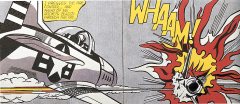
|
What? "Whaam!" When? 1963 Who? Roy Lichtenstein Why? Painting of comic strip, intensity of emotion/removed and technical way of drawing Cold War Hyper masculine violence "Copied" Living in comics Glorification of war Cold mechanized warfare detachment |
|
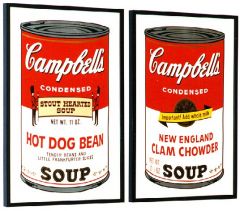
|
What? "Campbell's Soup Cans"
When? 1962 Who? Andy Warhol Why? Displayed like cans in a grocery aisle Flavor per canvas inspired by mass produced printed advertisements Silk screening Relocation, change meaning of art Cheap advertisement confronting industrial culture questioning, can this be art? nothing singular |
|
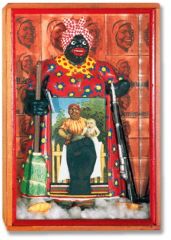
|
What? "The Liberation of Aunt Jemima"
When? 1972 Who? Bettye Saar Why? Objects and stereotyped depictions of African americans from Jim crow era Mamie: broom and shotgun Re appropriation of derogatory images Protest and empowerment demand of agency within society cotton, mulato baby, smiling mamie, black power fist, hand grenade warrior taking back the stereotype from the maker 3D collage |
|
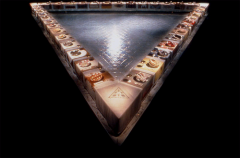
|
What? "The Dinner Party" When? 1979 Who? Judy Chicago Why?The Dinner Party comprises a massive ceremonial banquet, arranged on a triangular table with a total of thirty-nine place settings, each commemorating an important woman from history. The settings consist of embroidered runners, gold chalices and utensils, and china-painted porcelain plates with raised central motifs that are based on vulvar and butterfly forms and rendered in styles appropriate to the individual women being honored. The names of another 999 women are inscribed in gold on the white tile floor below the triangular table. her goal was to introduce the richness of women’s heritage into the culture rising symbol of liberation, up and down, currents of woman history pushing off table, women dont belong on table international and national news brought women back into history books |
|
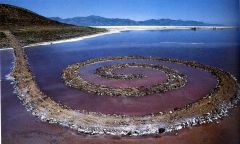
|
What? "Spiral Jetty" When? 1970 Who? Robert Smithson Why? art and place traversing artwork permanent flux artwork directly in landscape natural shape in unnatural setting unexpected permanence change in natural environment nuances of particular moments ephimerality |
|

|
What? "The Vietnam Veteran's Memorial" When? 1982 Who? Maya Lin Why? names of dead in chronological order of death reflective wall, linking past and present Rise and fall of wall Wound healing requires participation, touching it |
|
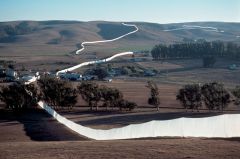
|
What? "Running Fence" When? 1976 Who? Christo and Jean-Claude Why? an 18-foot-high stretch of white, billowing nylon curtains that extended 24.5 miles along the hills of Sonoma and Marin counties for two weeks in September 1976. The sheer beauty of the light and weather playing across the fabric of the fence stood in sharp contrast to the underlying issue of division and limitations that fences generally convey. For Christo and Jeanne-Claude, the fence embodied larger issues of human freedom and constraint. togetherness jobs and material for residents |
|
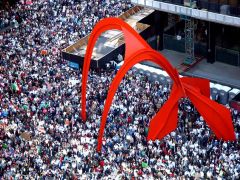
|
What? "Flamingo" When? 1974 Who? Alexander Calder Why? completely stable abstract sculpture human participation and interaction alludes to natural and animal realm dynamism contrast with buildings, buildings frame it industrial materials echo skyscrapers |

